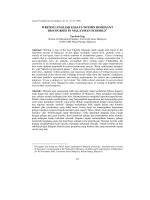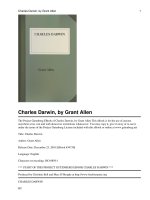where you may get it wrong when writing english
Bạn đang xem bản rút gọn của tài liệu. Xem và tải ngay bản đầy đủ của tài liệu tại đây (4.33 MB, 219 trang )
LEON BARKHO
WHERE YOU MAY GET
IT WRONG WHEN
WRITING ENGLISH
A PRACTICAL GUIDE FOR
STUDENTS, TEACHERS AND
PROFESSIONALS
Download free eBooks at bookboon.com
2
Where You May Get it Wrong When Writing English:
A Practical Guide for Students, Teachers and Professionals
1st edition
© 2016 Leon Barkho & bookboon.com
ISBN 978-87-403-1429-8
Peer review by Carol-Ann Soames, Jönköping University, Sweden
Download free eBooks at bookboon.com
3
WHERE YOU MAY GET IT WRONG
WHEN WRITING ENGLISH
CONTENTS
CONTENTS
1
2
3
4
5
Introduction
6
Quoting and Paraphrasing – Introduction
9
Tools
10
Quoting
17
How to Quote
18
Practical Guide
19
Paraphrasing
29
Practical Guide
30
Exercise
36
Subject and Verb Agreement
47
Exercise
48
The Possessive
55
Exercise
58
www.sylvania.com
We do not reinvent
the wheel we reinvent
light.
Fascinating lighting offers an ininite spectrum of
possibilities: Innovative technologies and new
markets provide both opportunities and challenges.
An environment in which your expertise is in high
demand. Enjoy the supportive working atmosphere
within our global group and beneit from international
career paths. Implement sustainable ideas in close
cooperation with other specialists and contribute to
inluencing our future. Come and join us in reinventing
light every day.
Light is OSRAM
Download free eBooks at bookboon.com
4
Click on the ad to read more
WHERE YOU MAY GET IT WRONG
WHEN WRITING ENGLISH
6
CONTENTS
Abbreviations and Acronyms
61
Introduction
61
What are They?
61
How to Deine Them
61
Points of Grammar and Style
66
Punctuation
69
Guide to Punctuation Marks
70
Exercise
80
Consistency
88
Consistency in the Tense of the Verb
88
Consistency in Listing
90
Consistency in Bullet Points
90
9
Currencies
94
10
The Progressive Tense
98
Exercise
99
7
8
11
12
13
14
15
Pronouns
103
Exercise
103
Sentences
113
What is a Sentence in English?
114
Exercise: Incomplete Sentences
124
Exercise: Awkward Sentences
127
Coherence
141
Exercise
168
Content Words
178
Exercise
178
Friendly Words
194
Index
214
Further reading
219
Download free eBooks at bookboon.com
5
WHERE YOU MAY GET IT WRONG
WHEN WRITING ENGLISH
INTRODUCTION
INTRODUCTION
his book is based on my experience both as English language teacher and editor. I joined
Sweden’s Jönköping International Business School in 2001. he milieu of the school is
truly international. Many members of its faculty (more than 70%) come from abroad. Its
student population is even more diverse. he school, which ofers all its courses in English,
attracts hundreds of foreign students every year, taking advantage of English as a medium
of instruction, but more importantly, beneiting from the generosity of Sweden’s education
system, which forbids collection of tuition fees from students whether Swedes or non-Swedes.1
As part of my English language teaching tasks at the school, I had to edit dissertations,
scholarly papers, articles and reports and polish them from the language point of view. he
corrections I made helped some of my colleagues at the university to get printed in some of
the most prestigious scholarly journals and publications. But as I was editing and teaching,
I found that many of the errors were recurrent in the scores of dissertations and hundreds
of papers, articles and reports I was asked to have a look at. hen, I began collecting these
errors and tabulating them. In the course of time, the corpus grew to thousands of examples,
many of which I included in the handouts I gave to my students. Talking about errors in
the class and how to identify and correct them is something students enjoy most. But one
word of caution: teachers will have to present the errors to their students as anonymously
as possible. As teachers, our job is not to embarrass our students. Our job is to encourage
and motivate them.
he Purpose
his book is speciically written to improve the skill of writing in English. It is the product
of almost a decade of teaching, editing and researching at the university. here is no shortage
of books written in English and targeting English language learning errors. But I regret
to say that most of the stuf I have seen is rarely based on authentic material and samples
gathered over a long period of time. his book is corpus-based and is meant primarily
to help readers write English properly, without errors if possible. It is designed both as a
textbook and a publication that can be used by the majority of people as a guide on how
to improve their English writing skills.
Download free eBooks at bookboon.com
6
WHERE YOU MAY GET IT WRONG
WHEN WRITING ENGLISH
INTRODUCTION
Readers
I have a wide spectrum of readers in mind, ranging from high-school and university students,
to teachers, academics and professionals. Exercises and tips on how to identify erroneous
instances and pitfalls and ways to correct them make up the bulk of the book. here are
special chapters on diferent writing tools and skills in English. here are special chapters
on how to write, along with tips on how to link sentences and paragraphs together to
produce an essay. University students and academics have special chapters on quoting and
paraphrasing – the tools whose mastering is essential when writing.
he erroneous instances I discuss and analyze in the book are not selected haphazardly.
hey are among the most frequent samples which I have come across in my teaching and
editing. Each of the book’s 15 chapters deals with one particular area which I have found
to be problematic when writing English.
Grammar in Action
he book can be seen as “a grammar in action”. Grammatical concepts are simpliied but
not at the expense of accuracy. he book difers from mainstream English grammar and
English language teaching publications in several aspects. First, it heavily relies on language
usage rather than language theory. Second, it analyses and discusses authentic samples of
language, i.e. the errors foreign English learners may make when writing English. hird,
it provides plenty of exercises, all arranged and designed in a manner that difers from its
traditional English language teaching counterparts. Fourth, readers are not left on their
own to struggle with the exercises. Each example starts with an explanation and a sample
of relevant error, which I hope they will try to solve on their own before moving to the
correct versions.
Download free eBooks at bookboon.com
7
WHERE YOU MAY GET IT WRONG
WHEN WRITING ENGLISH
INTRODUCTION
Another fundamental diference is the use of citations for the grammar points the book
tackles. I have relied almost solely on mainstream British and American media outlets,
such as he New York Times (NY Times), he Washington Post, Newsweek, TIME, he
Economist, BusinessWeek, the Financial Times (FT), the BBC, he Wall Street Journal
(WSJ), he Guardian, he Daily Telegraph, the Los Angeles Times, Scientiic American,
he Independent, NPR (National Public Radio), and he Christian Science Monitor
(Monitor). I am not aware of the degree of signiicance non-English language scholars give
to mainstream media when compiling their lexicons and writing their grammar books in
their own languages. But in English, we see the outlets mentioned above as the benchmark
of proper English. How he New York Times, for instance, uses a word or constructs a
sentence is one of the better ways to tell what is prevalent in current English. For this
reason, English lexicographers and linguists cite profusely from these outlets when writing.
hanks
I owe a great deal to my colleague Lars-Olof Nilsson for the time he spent copy-editing the
book. My thanks go to Carol-Ann Soames and her tips and suggestions. I am indebted to
my undergraduate students who came to me praising my initial handout “One Hundred
and One Errors,” and asking whether I could turn it into a book. I am glad that their
dream has now come true.
Leon Barkho, Ph.D.
Jönköping University (Sweden), and Qatar University
Download free eBooks at bookboon.com
8
WHERE YOU MAY GET IT WRONG
WHEN WRITING ENGLISH
1
QUOTING AND PARAPHRASING – INTRODUCTION
QUOTING AND PARAPHRASING –
INTRODUCTION
his chapter examines the notions of quoting and paraphrasing in English. he remarks
here serve as a basis for the following two chapters, one on quoting and the other on
paraphrasing. Most of the examples I use to demonstrate the diferent ways these two
very important writing skills are cultivated in English are drawn from mainstream English
publications, like he New York Times. I have made certain changes, particularly in the
use of sources and reporting verbs, to make these examples of use to the wide spectrum of
readers the book targets.
We use quoting and paraphrasing frequently whether in speech or writing. When we
quote, we need to repeat exactly what someone else has said or written, usually with the
acknowledgement of the source. When we paraphrase, we try to restate or express in a
shorter or clearer way what someone has said or written, usually with the acknowledgement
of the source. In other words, quoting involves direct repetition of what others have said
or written while paraphrasing repeats what others have said and written but in diferent
words. Paraphrasing, or expressing the ideas of others in your own words, is an important
part of writing. It allows you to extract and summarize essential points, while at the same
time making it clear from whom and where you have got the ideas you are discussing.
It may be desirable to quote the author’s original exact words. If you do so, keep the
quotations as brief as possible and only quote when you feel the author expresses an idea
or opinion in such a way that it is impossible to improve upon it, or when you feel that
it captures an idea in a particularly succinct and interesting way.
Also try to keep direct quotations at a minimum. Good authors paraphrase more than quote
and if they are obliged to use direct quotations, they mainly do it in the following instances:
• when the wording of the original is particularly pertinent to an idea they are
discussing and cannot be improved upon
• when they want to mention or accept authority to support their line of argument
• to avoid any ambiguity or misrepresentation of source material.
Download free eBooks at bookboon.com
9
WHERE YOU MAY GET IT WRONG
WHEN WRITING ENGLISH
QUOTING AND PARAPHRASING – INTRODUCTION
It is essential to acknowledge any material quoted directly or indirectly. Be careful to use
borrowed material sparingly and selectively. he indiscriminate use of quotations is as bad
as a lack of them. You will certainly not make a good impression by submitting work which
is full of quotations.
TOOLS
In English, we have certain linguistic tools at our disposal to quote and paraphrase at ease.
Here is a summary of these tools with examples from major U.S. and British media outlets,
which you can easily apply when writing reports, articles, research papers or dissertations.
USE OF PUNCTUATION MARKS
Since our main concern is writing rather than speech, it may be useful to start by a short
review of the punctuation marks we need when quoting or paraphrasing (see Chapter 7).
Any quotation needs punctuation marks (single or double inverted commas). hese should
enclose what is quoted. Other punctuation marks placed inside the quotation by the writer
include commas, periods, question marks and exclamation marks. Note that the inverted
commas indicating a quotation in English may be single or double, but always try to be
consistent and follow the style sheet of your institution. he role punctuation marks play
in quoting and paraphrasing is examined thoroughly in the next two chapters.
GRAMMAR POINT
English grammar books tackle quotation and paraphrasing under the heading of direct and
indirect speech. he subject is broad and sometimes diicult to grasp when only seen from
a linguistic point of view, but it has wide practical applications in speaking and writing. he
following is a summary of the major points of grammar which you need to consider when
quoting or paraphrasing. hey are discussed in much greater detail with ample examples in
the chapters dedicated to quoting and paraphrasing (see Chapters 4, 5, 11, and 12).
NOTES ON THE USE OF TENSE
◊ he use of tenses (form of the verb) is important when quoting and paraphrasing.
What form reporting verbs such as say, ask, argue, tell, add, etc., have in diferent
situations is essential to credibility and meaning and the tenses of the text in general
(see Chapter 2).
◊ he reporting verb of a quotation may be in the present or past. his often but
not always afects the tenses of the paraphrase (see 1.4–1.9).
◊ Tense changes often occur when paraphrasing since the original spoken or written
words are changed and the meaning is preserved. But remember you need to be
consistent in the use of tense (see Chapter 8).
Download free eBooks at bookboon.com
10
WHERE YOU MAY GET IT WRONG
WHEN WRITING ENGLISH
QUOTING AND PARAPHRASING – INTRODUCTION
◊ You can achieve continuity when paraphrasing through the use of linking phrases
like: The author went on to say that, he continued that, he added that, etc.
Such forms remind the reader that the text is a paraphrase.
◊ When paraphrasing you do not repeat the speaker or writer’s exact words. Paraphrasing
usually takes place in the past, so the reporting verb is often in the past. As a
result, the tenses of the reported clause are usually ‘moved back.’ his ‘moving
back’ of tenses is called backshift in linguistics. A useful general rule is ‘present
becomes past and past becomes past perfect.’ But past modals and the past perfect
are unchanged, since no further backshift is possible (see Chapter 3).
◊ You often need to change your pronouns when paraphrasing, depending on the
meaning of the text and what the pronoun refers to (see Chapter 3).
◊ You may need to make some necessary time and place changes when paraphrasing
in relation to the changes in tense (see Chapter 3).
◊ You also need to change your modal verbs from present to past. But you have
to be careful because modals are not always easy to use in English.
◊ he rules about tense sequence (see Chapter 8) also apply to questions: X
asked whether/if family-owned companies were happy with the presence of
foreign investors.
360°
thinking
.
Discover the truth at www.deloitte.ca/careers
Download free eBooks at bookboon.com
11
© Deloitte & Touche LLP and affiliated entities.
Click on the ad to read more
WHERE YOU MAY GET IT WRONG
WHEN WRITING ENGLISH
QUOTING AND PARAPHRASING – INTRODUCTION
◊ You need to change the inversion of subject and reporting verb in quoted questions
if you want to paraphrase them back to a statement word order (subject + verb):
X wondered whether/if medium-sized irms relied on foreign labour.
◊ Note that Do/Does/Did disappear when paraphrasing quoted Yes/No question:
“Did the investors help in the provision of public utilities?” X asked whether
the investors helped in furnishing the region with municipal services.
◊ If and whether are interchangeable after reporting verbs like ask, want to know,
wonder, etc., but whether conveys slightly greater doubt. Some verbs, like discuss,
are followed by whether. Unlike that, if and whether (see 15.37) cannot be omitted
after reporting verbs.
◊ When paraphrasing, you also need to change the inversion of subject and reporting
verb in quoted questions starting with where, why, what, who, when and how back
to a statement word order (subject + verb): “Why have the multinationals invested
so heavily in emerging markets?” X wanted to know why the multinationals
had poured so much money into the emerging markets.
◊ here is no inversion of subject and reporting verb when the question is about the
subject: “Who invests in emerging markets?” X asked which irms invested in
emerging markets. “Which irm makes these parts?” X asked which irm made
these parts.
General Prose and Academic Writing
1.4 In general prose (and to a lesser degree in academic writing), the prime verb in a sentence
is often in the past tense. Newspapers generally tend to report past events. Consistency (see
Chapter 8) in the sequence of verbs means that the governing verb in a sentence decides the
tense of other verbs in the same sentence. When paraphrasing, the reporting verb functions
as the prime verb if the attribution comes at the beginning of the sentence:
Warren E. Bufett said he planned no major changes to Berkshire’s management practices.
(NY Times)
1.5 But it is acceptable in today’s English to have the governing verb in the present tense
though the reference is the recent past:
Gary Kennedy, the director of geriatric psychiatry at Monteiore Medical Center in the
Bronx, says psychological care is “equally if not more important than” medical care for
this group. (NY Times)
Much existing literature on the aging population has been negative, he says. (NY Times)
And yet the medical dictum says that for incurable diseases, the only recourse is prevention.
(NY Times)
Download free eBooks at bookboon.com
12
WHERE YOU MAY GET IT WRONG
WHEN WRITING ENGLISH
QUOTING AND PARAPHRASING – INTRODUCTION
1.6 In academic writing, the prime verb (when quoting or paraphrasing, see Chapters 2 and
3) can be in the present tense though the reference is to works written in the past. But you
have to be consistent in the sequence of your tenses. Do not vacillate between the present
tense and past tense with your prime verbs when quoting and paraphrasing:
Damasio (1994: 256) wrote, “he efort to understand the mind in general biological
terms has been retarded by several decades, and it is fair to say it has barely begun.”
Damasio (1994: 256) writes, “he efort to understand the mind in general biological
terms has been retarded by several decades, and it is fair to say it has barely begun.”
1.7 We can refer to things or events in the future even if the reporting verb is in the
past tense:
Senator Arlen Specter of Pennsylvania said he would switch to the Democratic party.
(NY Times)
NOTE he tense in the paraphrase from he New York Times is in the past said and would, but
it means that the senator will join the Democratic party after he made the statement.
1.8 Consistency (see Chapter 8) in tense sequence is not necessary when describing
eternal truths:
He said the sun rises in the east and moves toward the west and there sets.
he scientist said the earth is round.
1.9 he governing or reporting verb controls the sequence of tense if the attribution comes
at the beginning of your sentence (paraphrase). As we shall see, it is possible to move
the reporting verb to the middle or the end of your sentence. In that case it can lose its
governing or controlling function of tense sequence:
hey also said that radiation levels would fall over the next two months with the
disappearance of short-lived iodine 131. (NY Times)
Radiation levels will fall over the next months, they also said, with the disappearance of
the of short-live iodine 131. (NY Times)
Download free eBooks at bookboon.com
13









